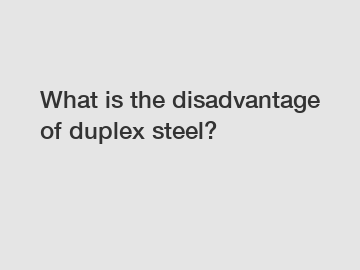What is the disadvantage of duplex steel?
What is the disadvantage of duplex steel?
Duplex steel is a highly sought-after material in various industries due to its exceptional strength, corrosion resistance, and cost-effectiveness. However, like any other material, it does have certain disadvantages that need to be taken into consideration. In this article, we will discuss the drawbacks of duplex steel and explore its impact on different applications.
1. Weldability Challenges:

One of the primary concerns with duplex steel is its welding properties. While it is relatively easier to weld compared to other stainless steels, it requires certain precautions and expertise. The formation of austenite and ferrite phases during welding can lead to welding defects like hot cracking and reduced toughness. Therefore, skilled welders and specialized techniques are essential for successful welding of duplex steel.
2. Sensitivity to Heat:
Duplex steel is known to have lower thermal conductivity compared to austenitic stainless steels. This characteristic can result in higher heat buildup during machining or cutting processes. The sensitivity to heat can lead to excessive heat generation, localized oxidization, and distortion of the material. Consequently, careful monitoring of heat input and the use of appropriate cutting tools become crucial while working with duplex steel.
3. Risk of Corrosion in Extreme Environments:
Although duplex steel exhibits excellent resistance to corrosion in many environments, it can be susceptible to certain types of corrosion under extreme conditions. For instance, it may be prone to stress corrosion cracking in chloride-rich environments, such as seawater. Additionally, exposure to elevated temperatures can promote precipitation of detrimental intermetallic phases, reducing the material's corrosion resistance. Therefore, the selection of duplex steel should be carefully evaluated depending on the specific operating conditions to prevent potential corrosion-related issues.
4. Cost Considerations:
Duplex steel offers a balance between cost and performance attributes, but it may still be more expensive compared to conventional stainless steels. The higher alloying elements present in duplex steel, such as chromium, nickel, and molybdenum, contribute to its superior properties but also drive up the material costs. Consequently, the affordability of duplex steel needs to be assessed based on the project requirements, considering the potential benefits it brings to the application.
In conclusion, while duplex steel possesses numerous advantages, it is important to acknowledge its disadvantages as well. Its weldability challenges require skilled personnel to ensure optimal performance. The material's sensitivity to heat demands careful machining practices and monitoring of heat input. Additionally, the risk of corrosion in extreme environments necessitates conscientious material selection. Lastly, the consideration of cost factors is crucial in deciding the feasibility of employing duplex steel. By addressing these drawbacks and taking suitable precautions, the potential for duplex steel to excel in various industries can be maximized.
Contact us to discuss your requirements of Hastelloy Woven Mesh, Monel Wire Mesh Features, Titanium Woven Wire Mesh. Our experienced sales team can help you identify the options that best suit your needs.

Comments
0